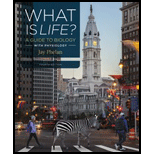
Concept explainers
To review:
What researchers concluded after observing a drop in the level of dissolved oxygen, following the disappearance of methane in an oil spill in the Gulf of Mexico.
Introduction:
The methane disappeared following the oil spill; if it was used up by bacteria in the ocean, a metabolic trace would have been left behind.
Explanation of Solution
The methane could have disappeared from the site of the oil spill, for two reasons. It could have either drifted off to another part of the Gulf, or bacteria could have metabolized the methane and used it up. If the bacteria had used the methane, they would have required a large amount of oxygen for
When researchers found a corresponding drop in the oxygen levels, it confirmed their suspicions that the bacteria metabolized the missing methane. They also found through DNA sequences, that there were DNA fragments known to be found in methane-eating microbes, in the Gulf.
The drop in the oxygen levels at the site of the oil spill confirmed that bacteria had consumed and metabolized the methane that had leaked during the spill. Through DNA sequencing methods, the researchers also found DNA fragments identified in methane-eating microbes.
Want to see more full solutions like this?
Chapter 18 Solutions
What Is Life? A Guide to Biology with Physiology
- Explain in a small summary how: What genetic information can be obtained from a Punnet square? What genetic information cannot be determined from a Punnet square? Why might a Punnet Square be beneficial to understanding genetics/inheritance?arrow_forwardIn a small summary write down:arrow_forwardNot part of a graded assignment, from a past midtermarrow_forward
- Noggin mutation: The mouse, one of the phenotypic consequences of Noggin mutationis mispatterning of the spinal cord, in the posterior region of the mouse embryo, suchthat in the hindlimb region the more ventral fates are lost, and the dorsal Pax3 domain isexpanded. (this experiment is not in the lectures).a. Hypothesis for why: What would be your hypothesis for why the ventral fatesare lost and dorsal fates expanded? Include in your answer the words notochord,BMP, SHH and either (or both of) surface ectoderm or lateral plate mesodermarrow_forwardNot part of a graded assignment, from a past midtermarrow_forwardNot part of a graded assignment, from a past midtermarrow_forward
 Human Biology (MindTap Course List)BiologyISBN:9781305112100Author:Cecie Starr, Beverly McMillanPublisher:Cengage Learning
Human Biology (MindTap Course List)BiologyISBN:9781305112100Author:Cecie Starr, Beverly McMillanPublisher:Cengage Learning Biology 2eBiologyISBN:9781947172517Author:Matthew Douglas, Jung Choi, Mary Ann ClarkPublisher:OpenStax
Biology 2eBiologyISBN:9781947172517Author:Matthew Douglas, Jung Choi, Mary Ann ClarkPublisher:OpenStax Biology: The Dynamic Science (MindTap Course List)BiologyISBN:9781305389892Author:Peter J. Russell, Paul E. Hertz, Beverly McMillanPublisher:Cengage Learning
Biology: The Dynamic Science (MindTap Course List)BiologyISBN:9781305389892Author:Peter J. Russell, Paul E. Hertz, Beverly McMillanPublisher:Cengage Learning





